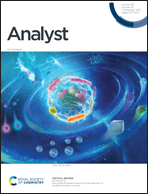Microcontact printing of choline oxidase using a polycation-functionalized zwitterionic polymer as enzyme immobilization matrix
Abstract
Highly sensitive and selective choline microbiosensors were constructed by microcontact printing (μCP) of choline oxidase (ChOx) in a crosslinked, polyamine-functionalized zwitterionic polymer matrix on microelectrode arrays (MEAs). μCP has emerged as a potential means to create implantable, multiplexed sensor microprobes, which requires the targeted deposition of different sensor materials to specific microelectrode sites on a MEA. However, the less than sufficient enzyme loading and inadequate spatial resolution achieved with current μCP approaches has limited adoption of the method for electroenzymatic microsensors. A novel polymer, poly(2-methacryloyloxyethyl phosphorylcholine)-g-poly(allylamine hydrochloride) (PMPC-g-PAH), has been developed to address this challenge. PMPC-g-PAH contributes to a higher viscosity “ink” that enables thicker immobilized ChOx deposits of high spatial resolution while also providing a hydrophilic, biocompatible microenvironment for the enzyme. Electroenzymatic choline microbiosensors with sensitivity of 639 ± 96 nA μM−1 cm−2 (pH 7.4; n = 4) were constructed that also are selective against both ascorbic acid and dopamine, which are potential electroactive interfering compounds in the mammalian brain. The high sensitivities achieved can lead to smaller MEA microprobes that minimize tissue damage and make possible the monitoring of multiple neurochemicals simultaneously in vivo with high spatial resolution.



 Please wait while we load your content...
Please wait while we load your content...